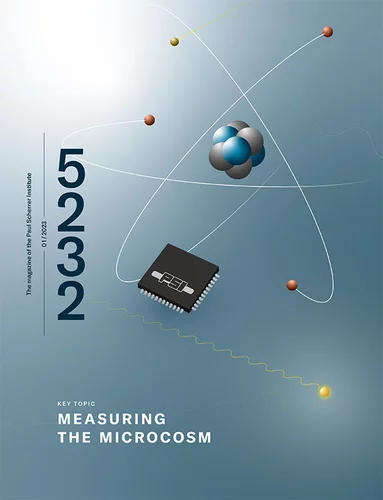Protons are among the building blocks of all everyday matter. Measuring these building blocks precisely not only provides well-founded insights into their structure, but also helps to refine the interchange between theory and experiment, thereby advancing the edifice of physics. Our video shows how scientists at PSI succeeded in measuring the radius of a proton.
Together with electrically neutral neutrons, positively charged protons form the atomic nucleus around which negatively charged electrons orbit. Protons are often depicted as small red balls – a simplification that we have had to resort to in our video too. However, this representation can allow us to forget that, in contrast to the point-like electron, the proton is by no means an elementary particle, but is itself made up of much smaller particles, so-called quarks and gluons. These particles give the proton its positive charge and its structure – the spatial distribution of the particles gives the proton its dimension – and it is this dimension that is to be measured.
To do so, scientists at PSI produced so-called muonic hydrogen – an artificial atom consisting of only one proton in the atomic nucleus, around which a negatively charged muon orbits. PSI is the only research facility in the world that can produce enough low-energy muons for such experiments.
Measuring the radius of a proton precisely helps us to better understand the structure of the proton and also serves as the basis for determining the so-called Rydberg constant – the most precisely measured fundamental constant in physics. This constant is incorporated in the definition of the SI base units, the International System of Quantities which defines such measures as the kilogram, the metre and the second. It is also an important pillar in the theoretical structure of physics. The more precisely the radius of a proton can be measured, the more precisely the Rydberg constant can be determined and the more precisely models of simple atoms or molecular systems can be calculated.
This video shows you how scientists at PSI were able to measure the radius of a proton.
You can find out more about this topic in the current issue of our magazine 5232 issue 1/2023.
Text: Paul Scherrer Institute/Benjamin A. Senn
Further information
- More light in the darkness – Article of 2 February 2023
- The link between theory and experiment – Article of 14 October 2021
- The hard worker from Val Mesolcina – Article of 14 September 2017
- Proton size puzzle reinforced! – Media release of 25 January 2013
Contact
Prof. Dr. Aldo Antognini
Laboratory for Particle Physics
Paul Scherrer Institute, Forschungsstrasse 111, 5232 Villigen PSI, Switzerland
Phone: +41 56 310 46 14, email: aldo.antognini@psi.ch [English, German]
Institute for Particle Physics and Astrophysics
ETH Zurich, Otto-Stern-Weg 5, 8093 Zurich, Switzerland
Copyright
PSI provides image and/or video material free of charge for media coverage of the content of the above text. Use of this material for other purposes is not permitted. This also includes the transfer of the image and video material into databases as well as sale by third parties.

